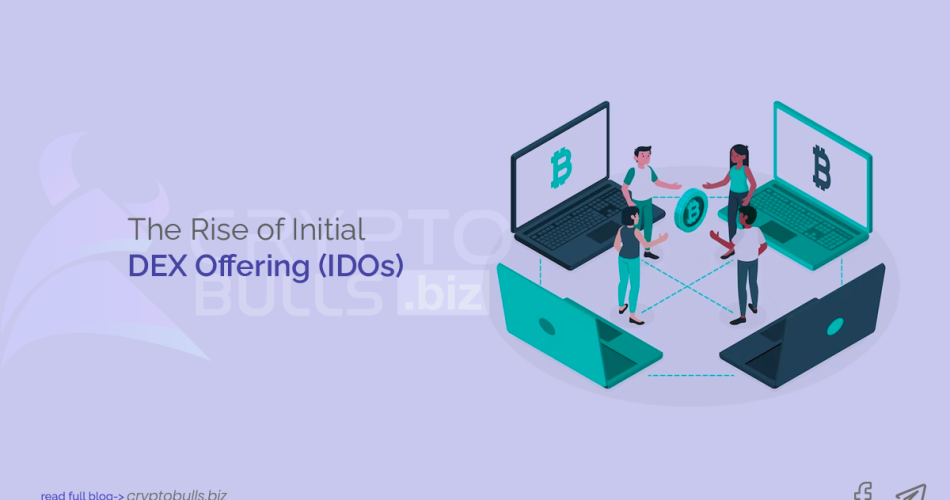Democratizing Crypto Investments: The Rise of Initial DEX Offerings (IDOs)
The evolution of the cryptocurrency industry has introduced innovative fundraising methods like Initial DEX Offerings (IDOs) as an alternative to the contentious Initial Coin Offerings (ICOs). While ICOs were unregulated token offerings on centralized exchanges that often lacked investor protections and due diligence, they gave rise to scams and mistrust in the crypto space. In contrast, IDOs operate on decentralized exchanges, leveraging smart contracts and liquidity pools to provide a more transparent and controlled fundraising approach, offering potential investors a safer and more promising route to support crypto projects in the decentralized finance ecosystem.
Successful IDOs now serve as a beacon of hope for the crypto community, helping restore trust and encouraging newcomers to participate in this transformative industry. One notable model is the Decentralized Exchange (DEX) model, which provides crypto investors with a more equitable crowdfunding method.
How Initial DEX Offerings (IDOs) Work
Initial Dex Offerings (IDOs) thrive within the decentralized exchange (DEX) ecosystem due to their unique features. DEXs offer immediate token liquidity, attracting liquidity pool providers with attractive rewards ensuring smooth operations for users. Many projects contribute to DEX liquidity by allocating a portion of their funds, a standard practice that helps sustain a liquid exchange. Some projects employ a proof-of-stake (PoS) consensus mechanism to encourage investors to hold their tokens, thereby discouraging early selling.
Launching an Initial Dex Offering (IDO) involves several important steps to ensure a successful fundraising campaign:
Step 1: Devise a Business Strategy
Begin by formulating a clear business strategy for your project. Define your goals, target audience, and the problem your project aims to solve. Establish a roadmap that outlines your project’s development milestones and how funds will be utilized.
Step 2: Create Marketing Collateral
Develop compelling marketing materials to promote your IDO. This includes a whitepaper detailing your project, its technology, and its value proposition.
Step 3: Visit a DEX Launchpad
Identify a decentralized exchange (DEX) launchpad that aligns with your project’s goals and values. Launchpads are platforms within DEXs that help facilitate IDOs.
Step 4: Create the Cryptocurrency
Develop your project’s cryptocurrency token. This typically involves creating a smart contract on a blockchain platform like Ethereum. Ensure that your token adheres to industry standards and is compatible with the DEX’s requirements.
Step 5: Launch the Token to Start Raising Funds
Once your token is ready, initiate the IDO on the chosen DEX launchpad. Promote the IDO within the crypto community and encourage investors to participate. Ensure that the launchpad handles the distribution of tokens and funds securely.
Launching an IDO requires careful planning, a strong marketing strategy, and collaboration with a reputable DEX launchpad to attract investors and successfully raise funds for your project.

Benefits of Initial Dex Offerings (IDOs)
- Enhanced Liquidity: IDOs use automatic market makers and liquidity pools on decentralized exchanges, ensuring that tokens have immediate liquidity without the need for a price oracle. This liquidity facilitates smoother trading and investment activities.
- Transparent Fundraising: IDOs provide an open and inclusive platform for fundraising, allowing a wide range of investors to participate. This eliminates the need for exclusive private investments, making the process more democratic and accessible.
- Lower Costs: IDOs are cost-effective for project teams as they primarily incur gas fees for deploying smart contracts, reducing the financial burden associated with traditional fundraising methods.
- Fast Trading: IDOs enable rapid trading as tokens become available for immediate trading upon issuance. Early investors can capitalize on price increases during the IDO, allowing for quicker returns on investment.
Problems with Initial Dex Offerings (IDOs)
- Lack of Control Mechanisms: The decentralized nature of IDOs means that there are limited control mechanisms for token issuers. This lack of oversight can lead to price fluctuations and potential issues in the fundraising process.
- Variable Token Prices: IDOs may see varying token prices as investors engage in swaps, making it challenging for all participants to access tokens at the initially listed price.
- Risk of Fake Tokens: The accessibility of launching an IDO can lead to the listing of fake or fraudulent tokens aiming to exploit initial liquidity. Investors may fall victim to “liquidity rug pulls,” resulting in financial losses.
Balancing the benefits and drawbacks of IDOs is crucial for both project teams and investors to navigate this fundraising method successfully while mitigating potential risks.
Examples of Successful IDOs
These real-life examples of successful Initial Dex Offerings (IDOs) illustrate the effectiveness of this fundraising method in the cryptocurrency space:
- Polkastarter: In 2020, Polkastarter conducted an IDO that raised nearly $900,000. This success demonstrated the potential of IDOs as a viable and efficient fundraising tool for blockchain projects.
- SushiSwap: SushiSwap, a prominent decentralized exchange and automated market maker protocol, experienced significant price appreciation following its IDO. The token price surged by over 150%, underlining the immediate liquidity and the potential for substantial returns that IDOs can offer to investors.
- Mina Protocol: Mina Protocol achieved remarkable success with its IDO, raising an impressive $18.75 million in capital. This example showcases how IDOs can be a powerful means for blockchain projects to secure significant funding for their development and growth.
These instances highlight the diverse applications and achievements of IDOs within the cryptocurrency ecosystem, ranging from smaller-scale fundraising to substantial capital generation and immediate market impact.
How to Participate in an IDO
Participating in an Initial Dex Offering (IDO) is a straightforward process, requiring a cryptocurrency wallet and access to the decentralized application of the chosen DEX. For example, on platforms like Polkastarter, one can use a Web3 wallet like Metamask, configure it, and visit the Polkastarter website. There, potential investors can browse a wide array of projects across various networks such as Ethereum, BNB Chain, Polygon, Celo, Avalanche, and soon Solana. Each project provides details on how to participate. Still, it’s essential to understand the specific conditions and nuances of each DEX before joining an upcoming IDO, ensuring a seamless and informed investment experience in the realm of decentralized finance.
Regulatory Considerations
Regulatory considerations are paramount in the cryptocurrency and blockchain space, especially when conducting token offerings like ICOs, STOs, and IDOs. Regulatory bodies in various countries have different approaches to these fundraising methods, which can affect their legality and compliance requirements. Issuers and investors must be aware of the regulatory landscape in their respective jurisdictions, ensuring they adhere to securities laws, tax regulations, and Know Your Customer (KYC) and Anti-Money Laundering (AML) requirements. Seeking legal counsel and regulatory guidance is essential to navigate this evolving and often complex regulatory environment to avoid legal issues and ensure the long-term success of token offerings.
Risks and Caution
Participating in an Initial Dex Offering (IDO) involves certain risks and calls for caution. While IDOs offer immediate liquidity and transparency, they operate in a decentralized and relatively unregulated environment, making them susceptible to smart contract vulnerabilities, fake tokens, and market volatility. Potential investors should conduct thorough due diligence on projects and understand the specific terms and conditions, as well as the risks associated with the upcoming IDO, to protect their investments and navigate the decentralized finance landscape wisely.
Conclusion
The evolution from Initial Coin Offerings (ICOs) to Initial Dex Offerings (IDOs) reflects the crypto fundraising landscape’s shift towards decentralization, transparency, and inclusivity. IDOs, facilitated by smart contracts and liquidity pools on decentralized exchanges, offer investors immediate access to tokens and have become a favored method in the decentralized finance space. As the crypto industry continues to evolve, both projects and potential investors need to navigate the complexities and seize the opportunities presented by upcoming IDOs while staying vigilant and informed.


